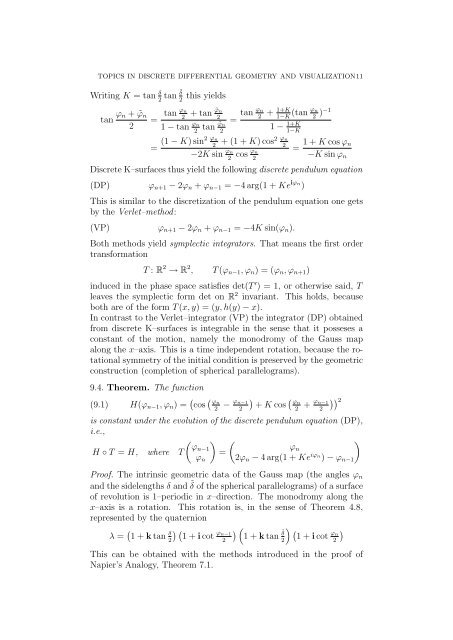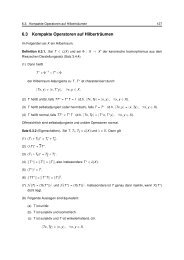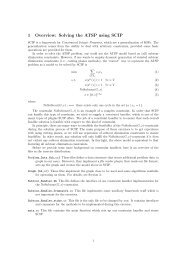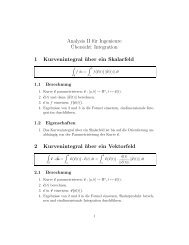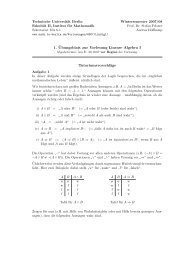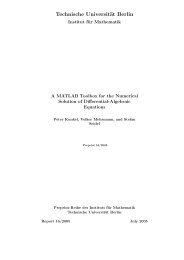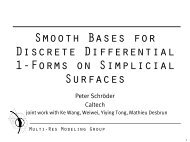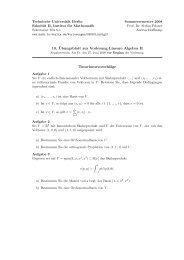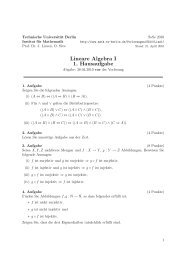Lecture notes - Institut für Mathematik - TU Berlin
Lecture notes - Institut für Mathematik - TU Berlin
Lecture notes - Institut für Mathematik - TU Berlin
You also want an ePaper? Increase the reach of your titles
YUMPU automatically turns print PDFs into web optimized ePapers that Google loves.
TOPICS IN DISCRETE DIFFERENTIAL GEOMETRY AND VISUALIZATION11Writing K = tan δ 2tan ϕ n + ˜ϕ n2==tan˜δ2tanϕn21 − tan ϕn2this yields+ tan ˜ϕn2tan ˜ϕn2(1 − K) sin2ϕn2−2K sin ϕn2=tanϕn+ 1+K2 1−K1 − 1+K1−K+ (1 + K) cos2ϕn2cosϕn2(tanϕn2 )−1= 1 + K cos ϕ n−K sin ϕ nDiscrete K–surfaces thus yield the following discrete pendulum equation(DP) ϕ n+1 − 2ϕ n + ϕ n−1 = −4 arg(1 + Ke iϕn )This is similar to the discretization of the pendulum equation one getsby the Verlet–method:(VP) ϕ n+1 − 2ϕ n + ϕ n−1 = −4K sin(ϕ n ).Both methods yield symplectic integrators. That means the first ordertransformationT : R 2 → R 2 , T (ϕ n−1 , ϕ n ) = (ϕ n , ϕ n+1 )induced in the phase space satisfies det(T ′ ) = 1, or otherwise said, Tleaves the symplectic form det on R 2 invariant. This holds, becauseboth are of the form T (x, y) = (y, h(y) − x).In contrast to the Verlet–integrator (VP) the integrator (DP) obtainedfrom discrete K–surfaces is integrable in the sense that it posseses aconstant of the motion, namely the monodromy of the Gauss mapalong the x–axis. This is a time independent rotation, because the rotationalsymmetry of the initial condition is preserved by the geometricconstruction (completion of spherical parallelograms).9.4. Theorem. The function(9.1) H(ϕ n−1 , ϕ n ) = ( cos ( ϕ n− ) ( ϕ n−12 2 + K cosϕn+ )) ϕ n−1 22 2is constant under the evolution of the discrete pendulum equation (DP),i.e.,( ) ()ϕn−1ϕH ◦ T = H, where T =nϕ n 2ϕ n − 4 arg(1 + Ke iϕn ) − ϕ n−1Proof. The intrinsic geometric data of the Gauss map (the angles ϕ nand the sidelengths δ and ˜δ of the spherical parallelograms) of a surfaceof revolution is 1–periodic in x–direction. The monodromy along thex–axis is a rotation. This rotation is, in the sense of Theorem 4.8,represented by the quaternionλ = ( 1 + k tan δ 2) (1 + i cotϕ n−12) ( 1 + k tan ˜δ2) (1+ i cotϕ n)2This can be obtained with the methods introduced in the proof ofNapier’s Analogy, Theorem 7.1.


